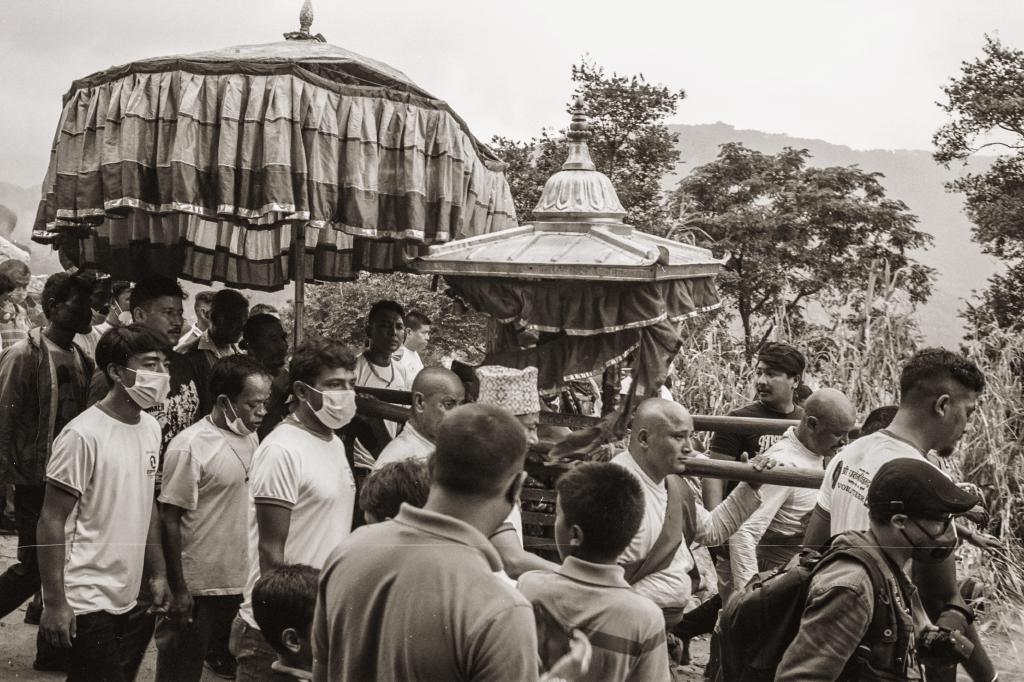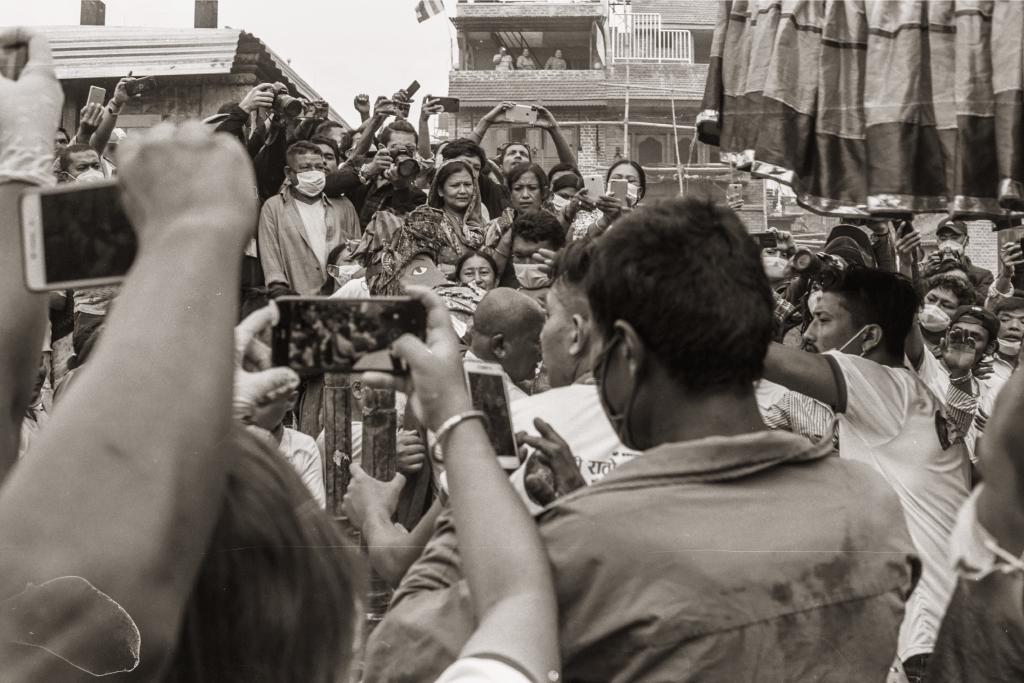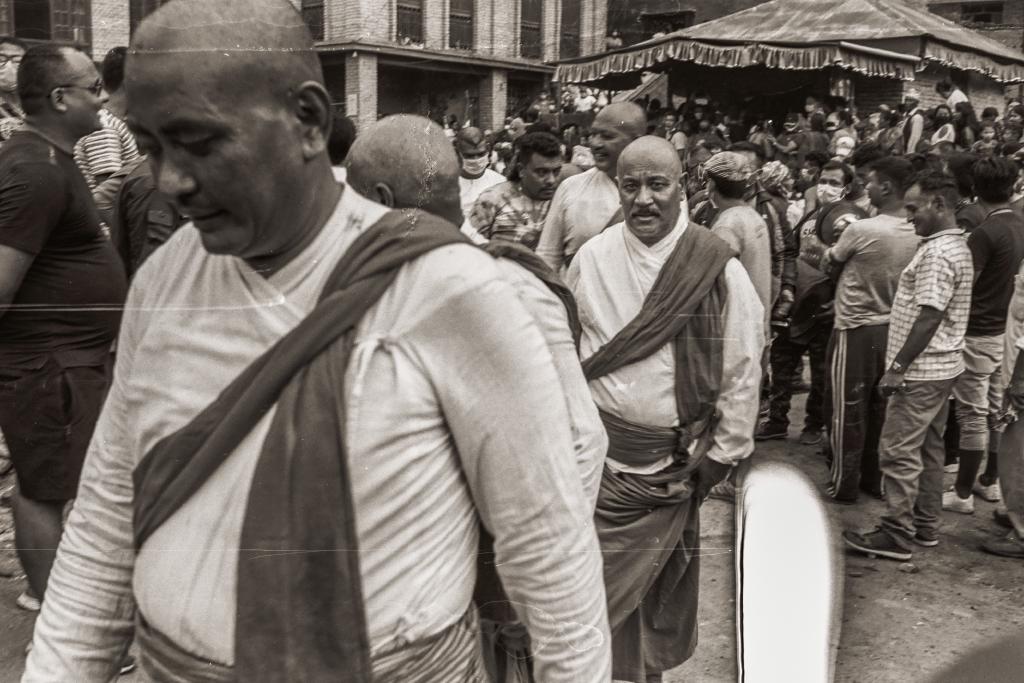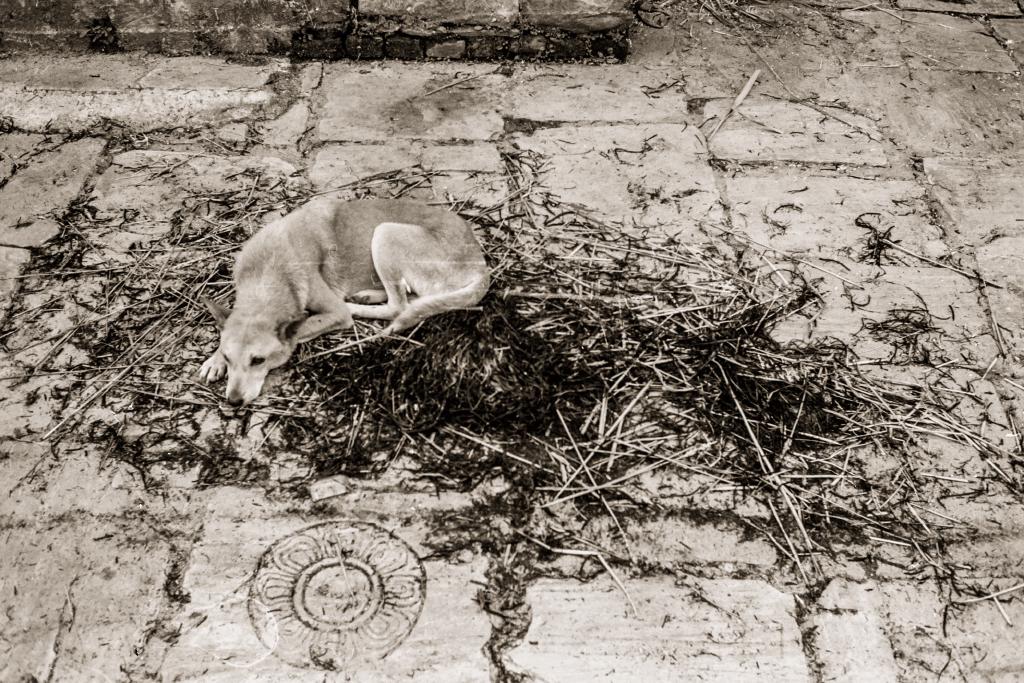 The procession reaches Bungamati, 2 km south of Patan.
The procession reaches Bungamati, 2 km south of Patan.
 People – the Jyapu community especially – are happy that they are able to fulfill their religious duty even if five months late.
People – the Jyapu community especially – are happy that they are able to fulfill their religious duty even if five months late.
 Bystanders burning straw as palanquin passes.
Bystanders burning straw as palanquin passes.
 Newar priests accompanied by a crowd transport Rato Machhendranath.
Newar priests accompanied by a crowd transport Rato Machhendranath.
 Arrival at Bungamati temple.
Arrival at Bungamati temple.
 Newar priests finished with their duty.
Newar priests finished with their duty.
 Street dog resting in burnt straw.
Street dog resting in burnt straw.
History
Rato Machindranath Jatra (Nepal Bhasa: बुंग द्यः जात्रा, Buṅga Dyaḥ Jātrā) is a chariot procession honoring the Vajrayani Buddhism deity of compassion Avalokiteśvara held in Lalitpur, Nepal. It is one of the greatest religious events in the city and the longest chariot festival celebrated in the country.
Buṅga Dyaḥ is also known as Raktalokitesvara Karunamaya and Rato Machhendranath and is revered as the giver of rain. The name Rato Machhendranath means Red Machhendranath in a reference to the color of the deity’s image. The chariot festival is held according to the lunar calendar, so the date is changeable. It begins on the 4th day of the bright fortnight of Bachhalā, the seventh month in the lunar Nepal Sambat calendar. However, due to COVID-19, festivities were delayed by about 5 months due to government imposition of a lockdown.
The chariot procession was instituted to celebrate the arrival of Buṅga Dyaḥ in Nepal and the end of a devastating drought. It was started when Narendra Deva was the king (640-683 AD).
Preparations for the festival begin with the construction of a 60-foot tall chariot at Pulchok at the western end of Lalitpur. When the chariot is complete, the image of Buṅga Dyaḥ from his temple is installed in it. Revellers then drag the chariot through the streets of Lalitpur on a tour that lasts a month. The chariot of Buṅga Dyaḥ is accompanied on the journey by a similar but smaller chariot of Chākuwā Dyah (चाकुवा द्यः).
The route of the chariot procession starts at Pulchok and passes through Gabahal, Mangal Bazar, Hakha, Sundhara, Chakrabahil, Lagankhel and ends at Jawalakhel. As per time-honored tradition, the chariot is pulled exclusively by women on the stretch between the localities of Iti and Thati. This part of the chariot procession is known as Yākah Misāyā Bhujyā (याकः मिसाया भुज्या).
The parade finishes at the open ground of Jawalakhel which is situated at the western side of Lalitpur. There, the festivities conclude with the ceremony of Bhoto Jatra, the display of the bhoto, a traditional Nepalese vest.
After the festival, the chariot is dismantled and the parts are stored until it is time for the procession the next year. Rato Machhendranath is taken to a temple in the nearby village of Bungamati, also known as the second home of the rain god. The deity spends the next six months in that temple. Source.
Folklore
Machhendranath, who was born a prince in Assam, had a younger brother, Gorakhnath, born from cow dung, who came to Nepal as yogi begging for alms, but he found no donors. Distressed, he tied the rain giving nagas (serpent gods) together, causing a terrible drought. Only Machhendranath could free the serpent gods. A tantric priest from Kathmandu and a porter from Patan were sent to summon the god, who came to Nepal as a bee and was trapped in a vase in Bungamati. After arguments between the king and the porter about where the god should live, it was decided that he would spend time in each place. Hence Rato Machhendranath’s two homes. Gorakhnath was persuaded to free the snake gods, yielding the necessary rain for the valley rice to grow. To this day, Machhendranath is revered as the compassionate one and is propitiated to bring the monsoon rains. Before Rato Macchendranath leaves Patan for Bungamati, the President of Nepal as well as the Patan Kumari (living goddess) come to pay their respects. When Nepal was still a kingdom, the king of Nepal would pay the respect to Rato Machhendranath. Source.